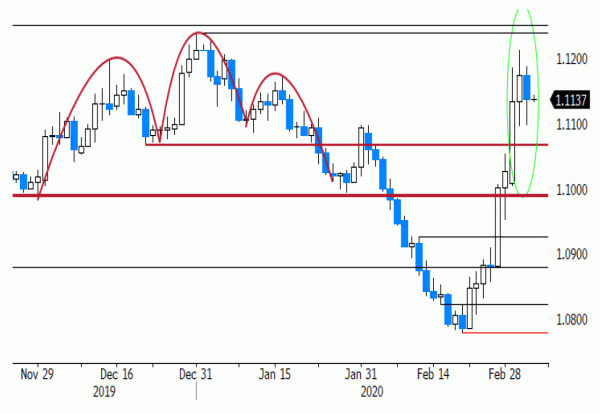- Rates: Late US rally on (isolated) fiscal spending
US Treasuries underperformed German Bunds yesterday after a late US stock markets rally (+4%) triggered by some additional US fiscal spending. Initiatives remain isolated and (relatively) small. Short term, they could provide some relief. Longer term, we fear that global March US eco data will be a rude awaking. - Currencies: USD enters (ST?) consolidation modus
The USD stabilized after recent setback yesterday. A rise in (US) equities and fiscal support helped to put a (temporary) floor for the USD currency. US yields holding near recent low levels suggest that markets see the loss of interest rate support for the dollar as being ‘permanent’. In this context we don’t expect a sustained USD rebound.
The Sunrise Headlines
- US equities rallied up to 4.5% (DJI) following US House approval for fiscal spending to cushion the blow from corona. Asian markets gain in lockstep amid hopes for more support worldwide. China (+2%) outperforms.
- The US House voted in favour of a $7.8 billion emergency spending bill including a.o. funds for medical supplies. The Senate is expected to vote on the bill later this week after which it will be sent to president Trump.
- The central bank of Poland kept rates unchanged at 1.50% and signaled steadiness till 2022 despite inflation at an 8-year high as the corona virus outbreak might cause growth to decelerate markedly.
- Non-voting member Bullard warned markets for assuming the Fed will cut rates again at the regular policy meeting in March after the 50 bps emergency rate cut earlier this week, saying policy rates are at the right place now.
- The RBA’s deputy governor Debelle said the central bank has room for just one more rate cut before they would have to start considering quantitative easing. The RBA cut rates from 0.75% to 0.50% on Tuesday.
- The Fed introduced a simplified capital rule for the largest US banks. The size of the buffer would be based on the annual stress-tests. Banks would face limitations on dividends and bonuses if capital fell below the required level.
- Today’s economic calendar eyes meagre with only secondary data due in the US (jobless claims). Bank of England’s Haldane and outgoing governor Carney speak. France and Spain tap the bond market.
Currencies: USD Enters (ST?) Consolidation Modus
USD enters ST consolidation pattern
Equities rebounded yesterday after a disappointing performance in the wake of the Fed emergency rate cut on Tuesday. There is no one-on-one link between the dollar and the moves in US interest rate and equity markets. However, investor hope that coordinated action from the Fed and the government might give the economy (and to markets) some leeway slowed recent USD decline. The US non-manufacturing ISM showed the economy was in good health before the virus outbreak but had little impact on the dollar and so was the US House approving a support package. EUR/USD closed at 1.1136 (open 1.1173). USD/JPY closed at 107.53 after touching a correction low below 107 early in Asia.
This morning, Asian equities join the risk rebound from WS yesterday, but gains are more moderate. The yuan is holding relatively strong (USD/CNY 6.94 area). USD/JPY gains stay modest despite the risk rebound (107.2 area). EUR/USD is showing no clear trend (1.1135 area). The Aussie dollar is holing near recent rebound top (0.6630 area) as the government prepares fiscal support.
Later today, the eco calendar is thin (US jobless claims and factory orders). Global market sentiment and headlines on the developing story of the corona virus will continue to global (FX) trading. Despite the risk-rebound, US (ST) yields are holding near recent very low levels as markets anticipate further Fed rate cuts. Those cuts probably won’t be reversed anytime soon even if the first hit from the corona virus on the economy would gradually fade over time. With the loss of interest rate support to be more or less permanent, we don’t see a trigger for a sustained USD rebound anytime soon, even if the outlook for the likes of the EMU and/or Japan stays very bleak too. The technical picture of EUR/USD improved after the rebound north of 1.11. EUR/USD 1.1240/50 is next reference on the charts. The EUR/USD picture stays constructive, but a break of that level might not be that easy. Some consolidation in the 1.10/1.1250 area might be on the cards.
Sterling succeded a nice (technical) rebound. The new BoE governor Bailey taking a rather guarded approach on an (emergency) BOE rate cut might have supported the sterling comeback. There are few important UK eco data today. Markets look out for fiscal support at next week’s UK budget. Recent sterling correction apparently has run its course. We expect consolidation in the 0.86 big figure short term.
EUR/USD: USD enters ST consolidation pattern, but permanent loss of interest rate support makes comeback difficult.













